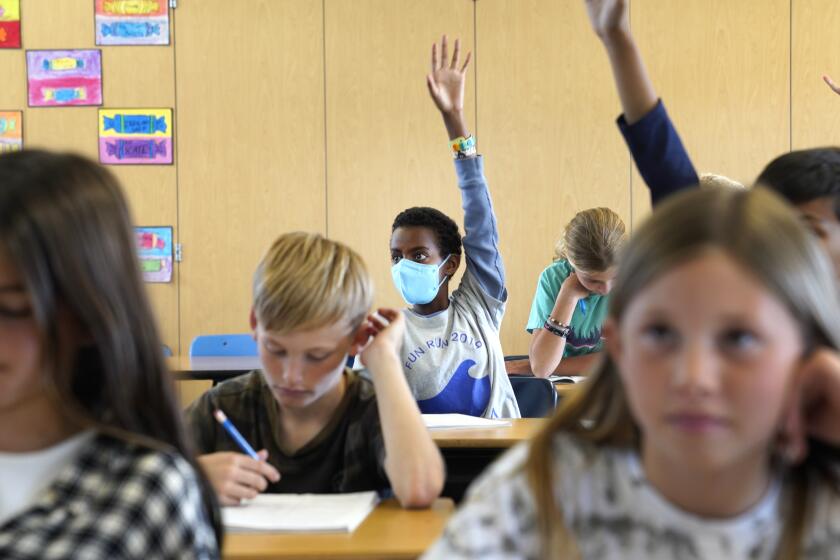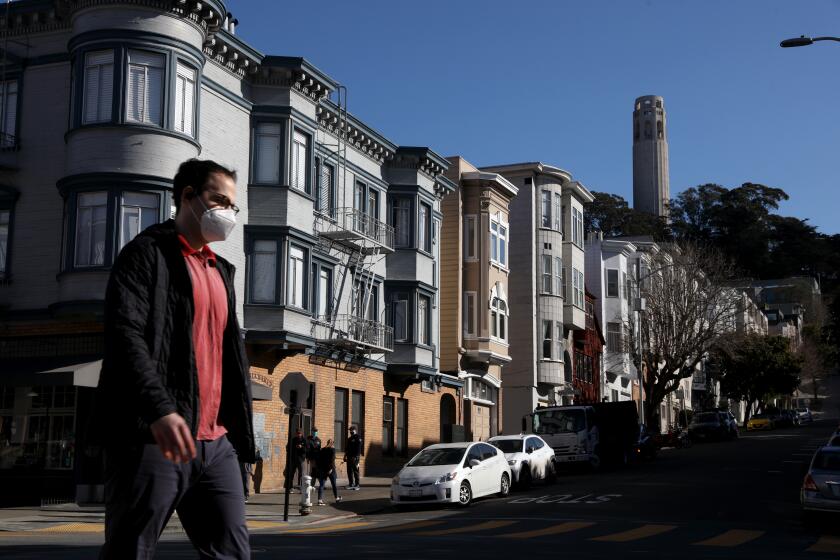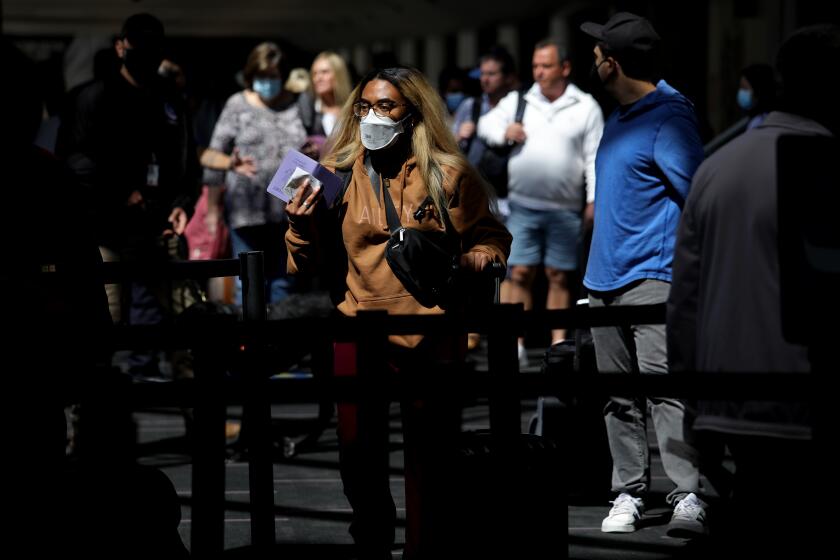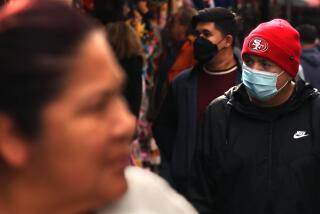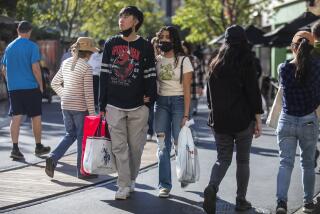California’s latest COVID-19 surge may be slowing, early data suggest
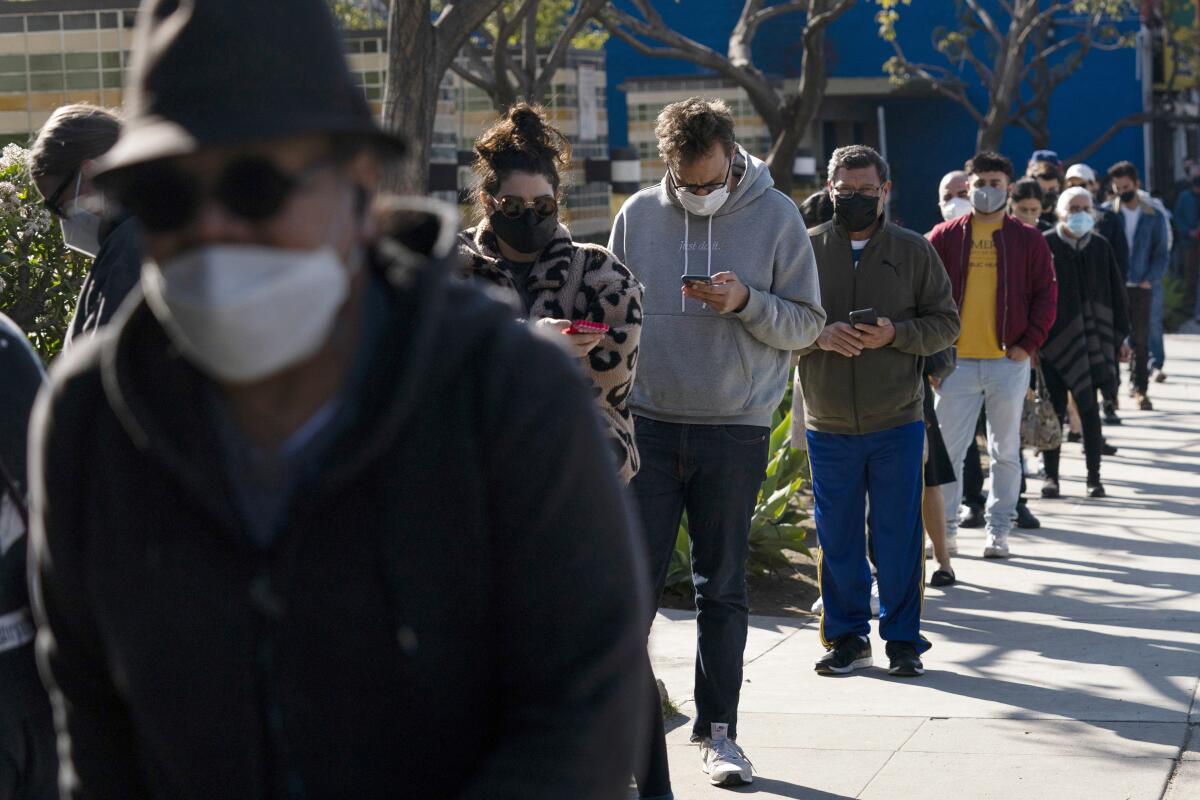
- Share via
There are initial signs that California’s latest wave of coronavirus cases may be slowing, although it’ll take more time to be certain.
California reported an average of 13,800 new coronavirus cases a day over the past week, according to data released Friday, down 12% from the previous week. That’s 247 cases a week for every 100,000 residents. A rate of 100 cases a week for every 100,000 residents is considered a high rate of viral transmission.
The trend is the first week-over-week decrease in cases in two months.
One big question, however, is whether reporting delays from the Memorial Day weekend are contributing to the decrease. It’s still possible that gatherings from the holiday weekend and during the summer will worsen transmission levels.
Some experts note that test positivity rates are still rising. San Francisco’s is more than 12%, while the rate in L.A. County was 5% as of Friday.
“This all means that the current wave has not gone away,” Dr. George Rutherford, a UC San Francisco epidemiologist and infectious-disease expert, said in a briefing Friday afternoon.
Officials are deciding how best to respond now that COVID-19 cases are rapidly rising after plunging in the spring.
“We do, however, have sewage data that would suggest that there’s some drop-off here in San Francisco, Davis, San Jose,” Rutherford said, referring to levels of coronavirus in wastewater. Still, there is conflicting data elsewhere in Silicon Valley, he said, with case rates fluctuating in other spots of Santa Clara County.
In L.A. County, no sewer systems reported a doubling of coronavirus levels in the last week, although coronavirus levels in sewage water still remain high, L.A. County Public Health Director Barbara Ferrer said in a recent briefing.
Los Angeles County reported a 4% week-over-week decrease in average daily coronavirus cases, according to a Times analysis of data released Monday, with the case rate falling from about 4,600 cases a day to 4,400. That’s the equivalent of 308 cases a week for every 100,000 residents.
“We will continue to monitor this closely to see whether or not we’ve plateaued,” Ferrer said.
Elsewhere in Southern California, San Diego County posted a 6% week-over-week decrease in its case rate; Orange County, a 12% decline; Riverside County, a 19% drop; Ventura County, a 13% decline; and Santa Barbara County, a 21% drop. San Bernardino County observed a 1% increase in its case rate.
San Diego County’s case rate was 278 cases a week for every 100,000 residents; Orange County, 192; Riverside County, 168; San Bernardino County, 173; Ventura County, 211; and Santa Barbara County, 224.
Nationally, case rates also may be starting to level off, from 106,000 cases a day for the seven-day period that ended May 29 to about 99,000 cases a day. In California, the San Joaquin Valley posted a 16% week-over-week reduction in average daily coronavirus cases as of Friday. The San Francisco Bay Area and Greater Sacramento reported a 17% reduction; and rural Northern California, a 36% drop.
The Bay Area still has the highest case rate in the state, with 317 cases a week for every 100,000 residents; the rate for Greater Sacramento is 226; the San Joaquin Valley, 166; and rural Northern California, 119.
Los Angeles, Orange, Riverside and San Bernardino counties have all seen upticks in coronavirus case rates.
Coronavirus-positive hospitalizations are still increasing statewide and in L.A. County. It typically takes a number of weeks for a reduction in cases to be reflected in hospitalizations.
“In California, we’re still having fairly substantial increases in hospitalizations,” Rutherford said Friday. There were 2,461 coronavirus-positive patients in California’s hospitals on Sunday, up 14% over a seven-day period, including 275 in intensive care units, up 10%.
In L.A. County, there were 530 coronavirus-positive patients in hospitals on Sunday, up 9% over a seven-day period, including 63 in intensive care, up 21%.
COVID-19 is making up a growing percentage of the reasons why people in L.A. County are seeking care at emergency rooms. About 6% of ER visits in the past week are related to the coronavirus; a month ago, the rate was 3.8%. L.A. County says there’s a medium level of concern when that percentage is 5% or more, and a high level of concern when it exceeds 10%.
“This reminds us that the infection for many is not mild,” Ferrer said.
The coronavirus has been spreading rapidly across California, setting up an anxious summer that could include the return of mask mandates.
Some doctors have said many coronavirus-positive patients are not being treated for COVID-19 illnesses and their infection status is incidental to why they’re in the hospital. At UC San Francisco, half of the coronavirus-positive patients are being treated for reasons unrelated to a coronavirus infection; at L.A. County’s public and private hospitals, that number is 60%.
Nonetheless, Ferrer said increasing numbers of coronavirus-positive patients will eventually strain hospital systems because of the additional resources needed. That’s why she has warned that, should worsening hospitalization trends hold, L.A. County could reimpose a universal mask mandate in indoor public settings.
But Ferrer also has expressed hope that L.A. County could avoid that measure if people take steps to reduce infections and transmission, such as testing ahead of events, getting up to date on booster shots and wearing masks indoors.
“If case numbers stabilize or decrease in the next two weeks, the rate of increase in hospitalizations could be a lot lower,” Ferrer said. “We all have the power to take steps to reduce the amount of viral spread, which ultimately reduces the number of people that are in the hospital with a positive COVID-19 infection.”
Other promising trends include a reduction in the number of weekly outbreaks at nursing homes, from 21 to 14 a week as of the last week of May, according to Ferrer. “And perhaps that reflects the increased safety measures recently instituted at all nursing homes,” she said.
Ferrer continued to strongly encourage universal masking among those 2 and older in indoor public settings.
“While there are still individuals questioning the effectiveness of masks, there is an impressive body of reputable research at this point that shows how masks reduce the risk for individuals and slow viral transmission in the community,” she said.
Ferrer pointed to research showing that the odds of testing positive were significantly lower for people who said they always wore a mask indoors compared to those who did not, especially for those who wore a respirator like a KN95 mask.
Democratic lawmakers pull proposed COVID vaccine requirements, blaming ebbs and flows of the virus, public inattention and opposition from unions.
At a panel discussion Thursday, UC San Francisco infectious-disease expert Dr. Peter Chin-Hong expressed hope that there would be another lull in the pandemic soon.
“I think we’ll probably hopefully have a decent July and August. Infections are already going down in much of the East Coast: Rhode Island, Massachusetts,” Chin-Hong said. Still, he said he’s concerned about a pair of new Omicron subvariants — BA.4 and BA.5 — that are causing some worry.
One question that hasn’t been answered is whether the refreshed version of the COVID-19 vaccines being tested by Pfizer and Moderna “are going to hold up against BA.4 and BA.5,” Dr. Ashish Jha, the White House COVID-19 response coordinator, said at the UC San Francisco panel discussion. “They’re going to have some data on that in the next couple of weeks.”
Looking more long-term, however, Jha said he was optimistic that, eventually, we won’t need booster shots every four to six months and an annual COVID-19 vaccination will be enough.
“It may take us a year or two to get there,” Jha said.
He also said he was hopeful the coronavirus’ rapid evolution will slow.
Eventually, Jha said, “you’re going to get a very broad range of immunity across the population because people will have been infected with different strains … so I think the ability of the virus to keep finding its way around the wall of immunity is going to get diminished.”
“The hard part is predicting when that will happen,” Jha said, adding that a new generation of vaccines that do a better job of blocking transmission and preventing infections would help get there.
More to Read
Sign up for Essential California
The most important California stories and recommendations in your inbox every morning.
You may occasionally receive promotional content from the Los Angeles Times.
